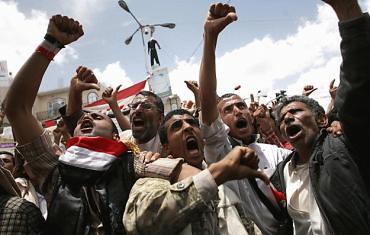
Demonstrations erupted in Yemen after President Saleh refused to sign an agreement to transfer power that was drafted by the Gulf Cooperation Council. Yemen has witnessed huge anti-governent demonstrations for months., a photo by Pan-African News Wire File Photos on Flickr.
U.S. prepares to restart military aid to Yemen
By LOLITA C. BALDOR
Associated Press
Last Modified: Mar 10, 2012 10:26PM
WASHINGTON — The Pentagon is planning to restart programs that would fund military training and equipment in Yemen, nearly a year after they were shut down because of escalating chaos in the embattled country.
While no agreements have been cemented, U.S. defense officials said as much as $75 million in military assistance could begin to flow later this year. The officials said the Pentagon and State Department are putting together a letter to send to Congress to request the aid be restarted.
The plan is in line with the Obama administration’s intention to provide significant security and civilian aid to Yemen in 2012-13 as long as the Middle Eastern country continues to move toward a new government and funding is kept out of the hands of insurgents.
One senior military official said discussions have begun over how best the United States can help Yemen, which is putting a new U.S.-backed government in place. The official said it may be difficult to relaunch the counterterrorism training that was suspended about a year ago because Yemeni forces are engaged in battle with the al-Qaida-linked insurgency.
Instead, the training program could shift to focus less on fighting tactics and more on how to plan combat operations and strategize against the enemy.
Officials spoke on condition of anonymity because no final decisions have been made.
Yearlong protests across Yemen, coupled with pressure from the U.S., led to the ouster of longtime Yemeni ruler Ali Abdullah Saleh. U.S. leaders have said they believe that newly inaugurated Yemeni president, Abed Rabbo Mansour Hadi, will be a good partner to the U.S.
The renewed effort come as the threat from al-Qaida in the Arabian Peninsula also goes through its own transition. While often described as the top terror threat for strikes inside the U.S., the group hasn’t surfaced as a key player in any domestic threats for more than a year.
The killing in a U.S. drone strike last fall of Anwar al-Awlaki, the U.S.-born radical militant cleric, has set back the group’s terror efforts outside Yemen. Al-Awlaki has been linked to the planning and execution of several terror attacks targeting U.S. and Western interests, including the attempt to take down a Detroit-bound airliner in 2009 and the plot to bomb cargo planes in 2010.
But it’s hard to tell how long the lull may last.
“What we don’t necessarily know is are they going to be focusing much more on Yemen, or is it a short term thing, to be able to build up time and capacity to be able to strike at a far enemy,” said Frank Cilluffo, director of a homeland security studies program at George Washington University who served as White House domestic security adviser to President George W. Bush.
Officials warn that the group has taken broad advantage of the unrest in Yemen to expand its foothold in the south, capture weapons, ammunition and equipment and score successes against the Yemeni military.
Yemeni military officials said Saturday that two U.S. airstrikes killed at least 18 al-Qaida-linked militants in an evening attack on a central province that had been partly overrun by the group this year. A U.S. Central Command spokesman declined to comment on any American role in the strikes.
Al-Qaida in the Arabian Peninsula “has been degraded by the strike and the loss of al-Awlaki, but that doesn’t mean they are not a threat,” said Stewart Baker, a former assistant secretary at the Department of Homeland Security who is now with the law firm of Steptoe & Johnson. “Their talent pool was thin and made thinner.”
But counterterror experts cautioned that the al-Qaida affiliate has proved that it is willing to attempt attacks and fail, in the hopes of getting one success through. And Cilluffo said the group still represents the most active and focused domestic threat to the U.S., largely because the group’s bomb-maker Ibrahim al-Asiri is still alive and active.
The U.S. has poured more than $326 million in security and civilian assistance into Yemen since 2007, fueled by the escalating terrorist threat from al-Qaida in the Arabian Peninsula, which is based there. The funding flow, however, was abruptly turned off last year as political and security unrest raged.
Initial plans by the Pentagon to send at least $150 million in aid to Yemen last year were shut down and no new military aid was approved.
Pentagon leaders have as much as $350 million to spend on military aid to foreign countries this year, and according to congressional restrictions up to $75 million can be spent on Yemen. Congress also requires the Pentagon and State Department to defend the spending, including assurance that any assistance will be properly used.
On the civilian side, the State Department and the U.S. Agency for International Development, under a directive from the National Security Council, have begun a new review to assess the situation in Yemen following the recent presidential election and to determine how best to provide development support, according to a newly released government report.
Since 2007, Yemen has received about $316 million in U.S. civilian aid, including humanitarian, education, development and refugee assistance.
The military funding, in addition to providing counterterrorism training, has also paid for aircraft, radios, rifles, patrol boats, trucks and other equipment.
No comments:
Post a Comment